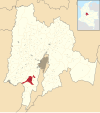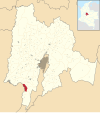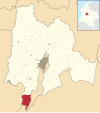Sutagao_people
The Sutagao are the Chibcha-speaking[1] indigenous people from the region of Fusagasugá, Bogotá savanna, Cundinamarca, Colombia. Knowledge about the Sutagao has been provided by scholar Lucas Fernández de Piedrahita.[2]
The Sutagao lived in the south of the department, including the greyed out southern Bogotá area; Sumapaz






